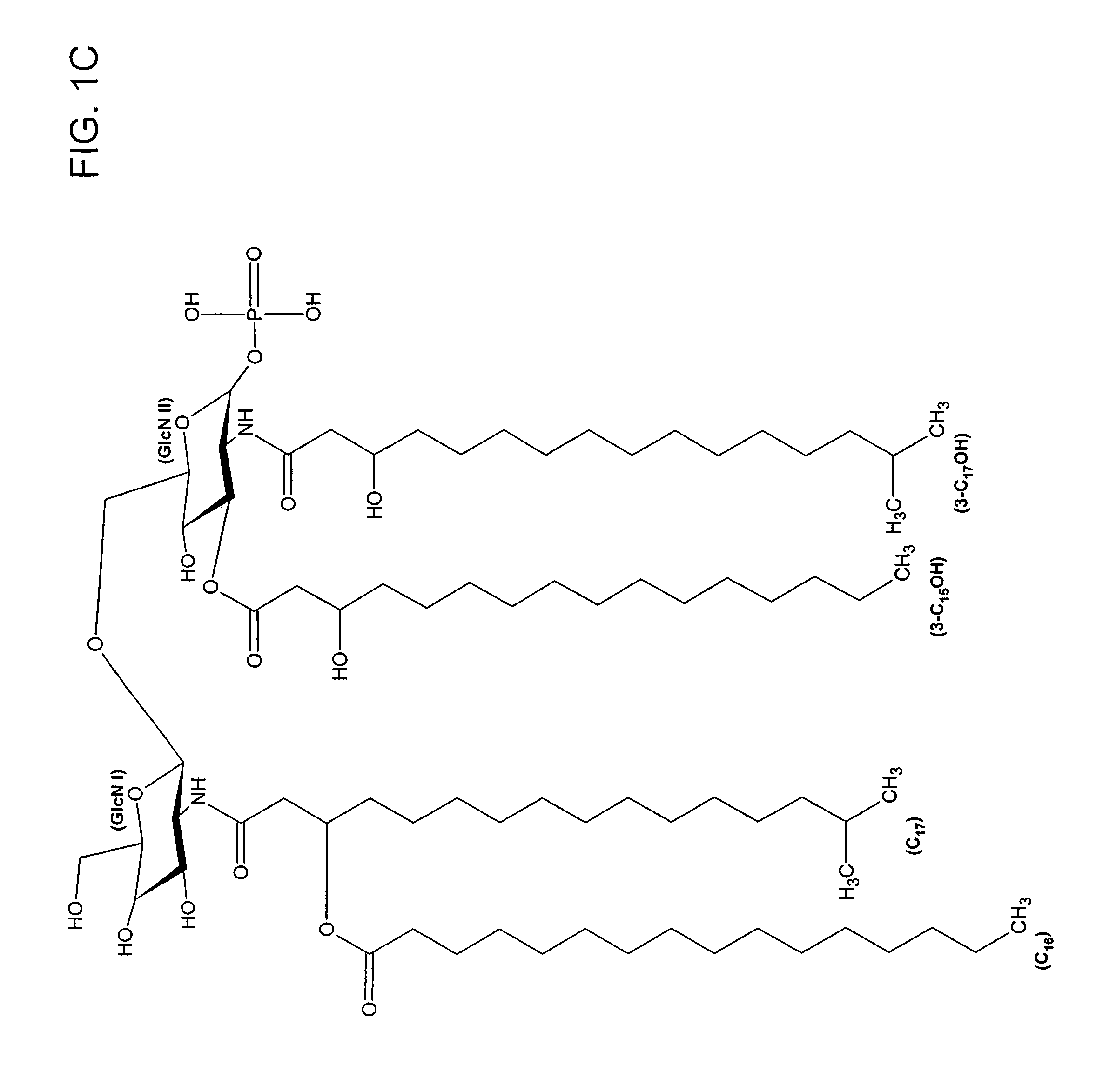Porphyromonas gingivalis 1435/1449 LPS as an immune modulator
a technology of porphyromonas gingivalis and immune modulator, which is applied in the field of porphyromonas gingivalis 1435/1449 lps as an immune modulator, can solve the problems of inability to elicit host responses in a manner similar, unstable and/or unacceptably low immunostimulatory effects of prior adjuvant systems, and achieve the effect of stimulating a protective immune respons
- Summary
- Abstract
- Description
- Claims
- Application Information
AI Technical Summary
Problems solved by technology
Method used
Image
Examples
example 1
P. gingivalis 1690 LPS
[0068]P. gingivalis strain 33277 was obtained from American Type Culture Collection. It was examined for purity, re-identified, and stored at −70° C. Cultures were made from frozen bacterial stocks to avoid repetitive subculture. Bacterial cells were grown for LPS isolation as follows: P. gingivalis was grown anaerobically at 37° C. for 24 hours in an enriched trypticase soy broth (30 gm / liter) containing yeast extract (Difco) 1 gm / liter; glucose 1 gm / liter; potassium nitrate 0.5 gm / liter; sodium lactate (Sigma L-1375) 1 ml / liter; sodium succinate 0.5 gm / liter; sodium fumarate 1 gm / liter; after autoclaving, filter-sterilized supplements were added (sodium carbonate 0.4 gm / liter; hemin (Sigma H-2250) 0.005 gm / liter; cysteine 0.4 gm / liter; and vitamin K (Sigma M-5625) 0.001 gm / liter). Stationary phase cells were employed for LPS isolation.
[0069]Bacteria were harvested by centrifugation and lyophilized. Bacteria were processed with the 45% phenol extraction method...
example 2
P. gingivalis 1435 / 1449 LPS
[0073]P. gingivalis bacteria were cultivated as described for Example 1 above and harvested by centrifugation and lyophilized. Bacteria were processed with the cold MgCl2-ethanol method according to the procedure of Darveau and Hancock, J. Bacteriol. 155:831-838 (1983), followed by lipid extraction. Folch et al., J. Biol. Chem. 226:497-509 (1957). The LPS was further purified to remove trace endotoxin protein by the method of Manthey and Vogel. J. Endotox. Res. 1:84-91 (1994).
[0074]Biochemical Analysis of Purified Lipid A.
[0075]Lipid A was generated from the LPS of P. gingivalis using the method of Caroff et al., Carbohydr. Res. 175: 273-282 (1988). Using MALDI-TOF, three distinct negative mass ions were observed, as seen in FIG. 3. Ogawa, FEBS Lett. 332:197-201 (1993); Kumada et al., J. Bacteriol. 177:2098-2106 (1995). One is a negative mass ion of 1195, representing a tri-acylated monophosphorylated form (FIG. 1A). Two other negative mass ions at 1435 (F...
example 3
Conversion of P. gingivalis Agonist 1690 LPS to Antagonist 1195 LPS
[0078]P. gingivalis bacteria were cultivated as described for Example 1 above and harvested by centrifugation and lyophilized. Bacteria were processed with the 45% phenol extraction method described in Somerville et al., J. Clin. Invest. 97: 359-365 (1996).
[0079]Biochemical Analysis of Purified Lipid A.
[0080]Lipid A was generated from the LPS using the method of Caroff et al., Carbohydr. Res. 175: 273-282 (1988). Using MALDI-TOF, a distinct negative mass ion at 1690 was observed. This represented a penta-acylated monophosphorylated form. This lipid A preparation was then subjected to concentrated NH4OH for 18 hours at room temperature. MALDI-TOF analysis showed that the 3 and 3′ acyl and acyloxacyl esters (but not linked fatty acids) were cleaved resulting in a m / z of 1195. Some residual m / z 1690 remained, and an unidentified m / z of 1440 which was present in the parent extract as well and appeared to be impervious to...
PUM
| Property | Measurement | Unit |
|---|---|---|
| size | aaaaa | aaaaa |
| concentrations | aaaaa | aaaaa |
| molecular negative mass | aaaaa | aaaaa |
Abstract
Description
Claims
Application Information
 Login to View More
Login to View More - R&D
- Intellectual Property
- Life Sciences
- Materials
- Tech Scout
- Unparalleled Data Quality
- Higher Quality Content
- 60% Fewer Hallucinations
Browse by: Latest US Patents, China's latest patents, Technical Efficacy Thesaurus, Application Domain, Technology Topic, Popular Technical Reports.
© 2025 PatSnap. All rights reserved.Legal|Privacy policy|Modern Slavery Act Transparency Statement|Sitemap|About US| Contact US: help@patsnap.com



